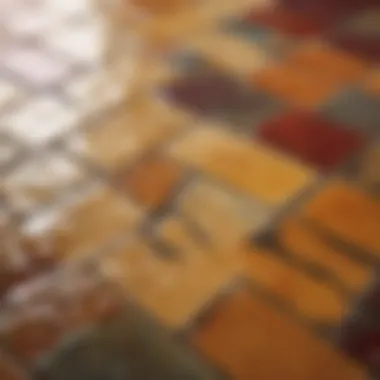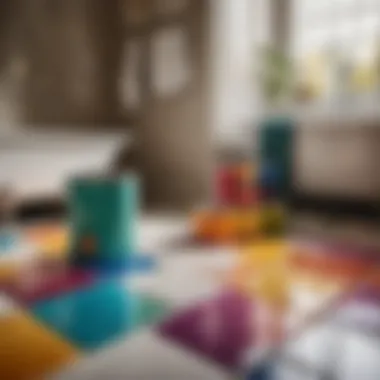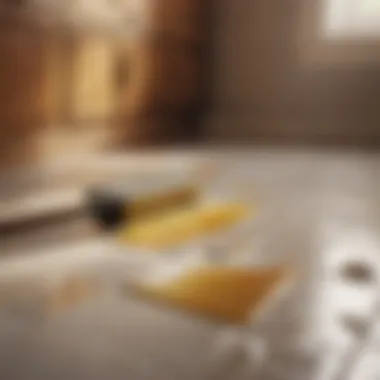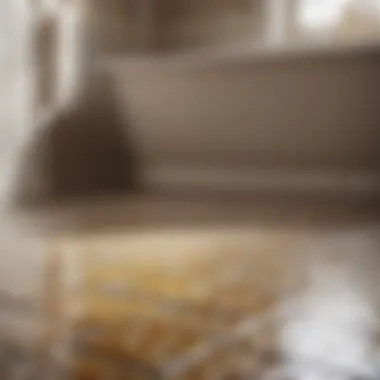Transform Your Bathroom with a Detailed Guide on Painting Floor Tiles


Materials:
- Epoxy paint specifically designed for tiles (measurements: the amount will depend on the square footage of your bathroom floor)
- Primer suitable for tiles (exact measurement: follow manufacturer's instructions based on the square footage)
- Medium-grit sandpaper
- TSP (trisodium phosphate) cleaner for degreasing
- Painter's tape
- Paint roller and tray
- Paintbrushes in various sizes
- Drop cloths for floor protection
DIY Steps:
- Preparation: Start by thoroughly cleaning the tile surface with TSP cleaner to remove any dirt or grime. Allow it to dry completely before proceeding.
- Sand: Gently sand the tiles to create a rough texture for better paint adherence. Clean off the dust from sanding thoroughly.
- Priming: Apply the primer evenly on the tiles. Let it dry according to the manufacturer's instructions before moving to the next step.
- Painting: Use a paint roller to apply the epoxy paint in thin, even coats. Work in sections, ensuring each coat is dry before applying the next.
- Detailing: Use a small paintbrush to touch up edges and corners for a precise finish.
- Drying: Allow the paint to dry completely as per the manufacturer's recommendations before walking on the newly painted tiles.
- Sealing (optional): Consider applying a sealant over the paint for added protection and longevity.
Technical Aspects:
- Tools: Ensure you have all the necessary tools handy, including brushes, rollers, and sandpaper.
- Timing: Follow the recommended drying times for each product used to achieve the best results.
- Techniques: Work methodically, starting from one end of the room to the other, to avoid stepping on wet paint.
DIY Project Process:
- Step 1 - Planning: Measure your bathroom floor to determine the amount of paint and primer needed. Choose a color that complements your bathroom decor.
- Step 2 - Preparation: Clear the bathroom floor of any rugs, mats, or obstacles. Protect fixtures and edges with painter's tape.
- Step 3 - Execution: Follow the outlined steps for cleaning, sanding, priming, painting, detailing, and sealing (if desired) with precision and care.
- Step 4 - Enjoying the Result: Once the paint has dried completely and you've cleaned up your workspace, step back and admire the refreshed look of your bathroom floor tiles.
Troubleshooting Tips:
- If you encounter drips or uneven coverage, gently sand the affected area and reapply paint.
- In case of paint smudges on unwanted surfaces, clean immediately with a damp cloth.
- For optimal durability, avoid harsh scrubbing or cleaning the painted tiles for at least a week after completion.
Introduction
Painting bathroom floor tiles can be a game-changer in upgrading the look and feel of your bathroom without a complete remodel. This comprehensive guide aims to walk you through the intricate process of transforming your bathroom tiles from drab to fab. From selecting the right materials to applying the finishing touches, every step is crucial in achieving a stunning result that reflects your personal style.
Overview of Painting Bathroom Floor Tiles
When it comes to renovating your bathroom, painting the floor tiles offers a cost-effective and creative solution. Whether you're looking to refresh outdated tiles or customize the space to your taste, painting provides a versatile option for rejuvenating your bathroom decor.
Painting bathroom floor tiles involves a series of steps starting from preparation, priming, painting, and finishing touches. The process requires attention to detail and proper execution to ensure a durable and aesthetically pleasing finish. By following this guide meticulously, you can elevate the ambiance of your bathroom and infuse it with your desired aesthetic.
To embark on this journey of transformation, gather your materials, prepare the tiles, protect surrounding areas, select the right primer, choose suitable paint, and seal the final result. Each stage plays a vital role in the overall outcome of your painted tiles and contributes to the longevity of the finish. Through careful planning and execution, you can achieve a fresh and stylish look that revitalizes your bathroom space.


Preparation
In any DIY project, preparation is key to achieving a successful outcome. When it comes to painting bathroom floor tiles, proper preparation ensures that the paint adheres correctly and lasts longer. This section will guide you through the essential steps required before you start painting.
Gather Materials and Tools
Before starting the project, gather all the necessary materials and tools. You will need items such as paintbrushes, roller or sprayer, painter's tape, sandpaper, primer, paint, and protective gear like gloves and goggles.
Ensure you have the right tools for the job to make the process smoother and more efficient. Quality tools and materials will also result in a higher-quality finish for your painted tiles.
Clean and Prepare the Tiles
Cleaning and preparing the tiles are crucial steps in the painting process. Start by thoroughly cleaning the tiles with a suitable cleaner to remove any dirt, grime, or residues. Allow the tiles to dry completely before proceeding.
Inspect the tiles for any damages or cracks. Repair any issues before painting to ensure a smooth surface. Use sandpaper to roughen the tile surface slightly, allowing better adhesion for the primer and paint.
Protect Surrounding Areas
Protecting the surrounding areas is essential to prevent accidental spills and splatters. Use painter's tape to mask off the edges of the tiles and any fixtures to create clean, sharp lines.
Cover floors and countertops with drop cloths or plastic sheets to avoid any paint stains. Ventilate the area well to disperse paint fumes and ensure a comfortable working environment.
By following these meticulous preparation steps, you set a solid foundation for the painting process, ultimately leading to a stunning transformation of your bathroom floor tiles.
Priming
In the process of painting bathroom floor tiles, priming plays a crucial role in ensuring a successful and long-lasting finish. Priming prepares the surface of the tiles for the paint to adhere effectively, enhancing durability and color retention. It serves as a foundational step that cannot be overlooked. Choosing the right primer is essential for achieving the desired results.
Selecting the Right Primer
When it comes to selecting the right primer for painting bathroom floor tiles, several factors need to be considered. Firstly, opt for a high-quality bonding primer that is specifically designed for use on tiles. This type of primer creates a strong bond between the paint and the surface, preventing peeling or chipping over time. Additionally, look for a primer that is suitable for high-moisture areas like bathrooms to ensure longevity and resistance to water damage.
Consider the type of paint you will be using on top of the primer. Some primers are formulated to work best with certain types of paint, so compatibility is crucial for a seamless application. Furthermore, assess the condition of the tiles to determine if any specific priming properties are needed, such as mildew resistance or stain-blocking capabilities.


Applying Primer to Tiles
The process of applying primer to bathroom floor tiles requires attention to detail and proper technique. Start by thoroughly cleaning the tiles to remove any dirt, grime, or residues that could affect adhesion. Use a mild detergent or a TSP (trisodium phosphate) solution to ensure a clean surface for the primer to bond effectively.
Next, allow the tiles to dry completely before applying the primer. Using a high-quality synthetic paintbrush or a foam roller, apply the primer evenly across the tiles in smooth, overlapping strokes. Ensure complete coverage and pay special attention to edges and corners.
Allow the primer to dry according to the manufacturer's instructions before proceeding with the painting process. This step is critical for the overall success of the project, as it sets the foundation for a flawless and professional-looking finish.
Painting
In the realm of this comprehensive guide on painting bathroom floor tiles, the stage of painting plays a crucial role in the transformation process. The act of painting is not merely an aesthetic enhancement but a practical solution to refresh and update the look of your bathroom without a full renovation. By painting your tiles, you have the opportunity to infuse your personal style and create a cohesive design scheme in your bathroom.
The significance of painting lies in its cost-effectiveness compared to replacing tiles entirely. Painting bathroom floor tiles is considerably more economical and time-saving, making it an ideal option for those looking to revamp their space on a budget. Moreover, painting allows for creativity and customization, enabling you to explore a myriad of color options to achieve the desired ambiance in your bathroom.
When it comes to painting, careful consideration should be given to factors such as tile material, surface preparation, and paint selection. These elements are pivotal in ensuring a successful painting endeavor and long-lasting results. By following the steps outlined in this guide, you can confidently navigate the painting process and elevate the visual appeal of your bathroom effortlessly.
Choosing Suitable Paint
Selecting the right paint for your bathroom floor tiles is a critical decision that significantly impacts the longevity and appearance of the painted surface. When choosing suitable paint, opt for products specifically formulated for high-moisture areas to withstand the humid environment of a bathroom. Look for paints that offer durability, water resistance, and mold and mildew protection to ensure longevity.
Consider the type of tile you are painting and choose a paint that adheres well to that specific material. For ceramic or porcelain tiles, epoxy or latex paints are recommended for their durability and moisture resistance. For natural stone tiles, opt for acrylic or epoxy-based paints designed for stone surfaces.
Additionally, factor in the color and finish of the paint. Lighter shades can help make a small bathroom appear more spacious, while darker hues add depth and sophistication. Choose a gloss, satin, or semi-gloss finish for easy maintenance and cleaning in a high-traffic area like the bathroom.
Applying Paint to Tiles
The process of applying paint to tiles requires precision and attention to detail to achieve a professional-looking finish. Start by preparing the tiles properly, ensuring they are clean, dry, and free of any debris or contaminants. Use painter's tape to mask off any areas you want to protect, such as baseboards or fixtures.
When applying paint, use a high-quality brush or foam roller designed for the type of paint you are using. Begin with a primer coat to promote adhesion and allow the paint to bond securely to the tile surface. Apply thin, even coats of paint, allowing each layer to dry completely before applying the next one.
To achieve a smooth and flawless finish, consider applying multiple coats of paint, building up the color intensity gradually. Take care to follow the manufacturer's instructions regarding drying times and curing periods to ensure the paint sets properly. Once the final coat is applied and dried, consider sealing the painted tiles with a clear acrylic sealer for added protection and longevity.


Finishing Touches
In this final phase of painting bathroom floor tiles, attention to detail is crucial to achieving a polished and long-lasting finish. The finishing touches not only enhance the aesthetic appeal but also contribute to the durability of the painted surface. By meticulously executing this stage, you ensure that your bathroom floor tiles maintain their freshly painted look for an extended period.
Sealing the Paint
Sealing the paint is a vital step in the process of painting bathroom floor tiles. It serves as a protective barrier that shields the painted surface from moisture, stains, and daily wear and tear. Selecting an appropriate sealant is essential to safeguard the newly painted tiles against potential damage. Opt for a high-quality sealant that is specifically designed for tiled surfaces to ensure maximum protection and longevity.
Cleaning Up
After completing the painting of bathroom floor tiles, proper clean-up is essential to restore the space to its original condition. Remove any painter's tape, drop cloths, and other protective coverings used during the project. Thoroughly clean the painting tools, such as brushes and rollers, to maintain their functionality for future use. Additionally, wipe down all surfaces to eliminate any residual paint splatters or drips. Cleaning up with precision not only enhances the overall appearance of the bathroom but also signifies the successful completion of the painting project.
Maintenance and Care
Maintaining and caring for your newly painted bathroom floor tiles is essential to ensure their longevity and preserve the beauty of your space. In this section, we will delve into the importance of proper maintenance and care routines, highlighting specific elements, benefits, and considerations.
Tips for Longevity
To enhance the durability and longevity of your painted bathroom floor tiles, consider the following tips:
- Regular Cleaning: Implement a routine cleaning schedule to remove dirt, grime, and stains promptly. Use gentle cleaning solutions and tools to avoid damaging the painted surface.
- Avoid Harsh Chemicals: Refrain from using abrasive cleaners or harsh chemicals that can deteriorate the paint finish. Opt for mild, non-abrasive cleaning agents to preserve the integrity of the paint.
- Use Protective Coatings: Applying a clear sealant or protective coating over the painted tiles can offer an extra layer of defense against moisture, stains, and daily wear and tear.
- Prevent Moisture Build-Up: Address any leaks or water damage in your bathroom promptly to prevent moisture from seeping into the painted tiles, which could lead to peeling or discoloration.
- Inspect for Damage: Regularly inspect the painted tiles for signs of wear or damage. Touch up any chipped or worn areas with matching paint to maintain a seamless finish.
Implementing these tips for longevity will help preserve the beauty and integrity of your painted bathroom floor tiles, ensuring they remain a stunning feature in your home for years to come.
Conclusion
One of the key benefits of painting bathroom floor tiles is the ability to customize the look of your bathroom without the expense of installing new tiles. Whether you prefer a fresh, modern aesthetic or a timeless, classic style, painting allows you to update your space according to your preferences. Additionally, maintaining painted tiles is relatively simple, requiring regular cleaning and occasional touch-ups to keep them looking their best.
When considering painting your bathroom floor tiles, there are a few essential considerations to keep in mind. Firstly, select high-quality materials and follow the preparation and application steps diligently to ensure a durable finish. It's also crucial to choose paint colors and finishes that complement your existing decor and align with your desired aesthetic. Lastly, proper maintenance and care will help preserve the painted tiles and extend the longevity of your project.
Enjoy Your Newly Painted Bathroom Floor Tiles
After following the steps outlined in this guide and putting in the necessary time and effort, it's time to enjoy your newly painted bathroom floor tiles. Take a moment to appreciate the transformation you have achieved and the fresh look you have brought to your bathroom space.
As you step back and admire the results, you'll likely notice how the painted tiles have revitalized the entire room. The cohesive color scheme and updated finish can create a sense of harmony and elegance in your bathroom, enhancing the overall ambiance.
To fully enjoy your newly painted bathroom floor tiles, consider adding complementary decor elements such as coordinating towels, rugs, and accessories to complete the look. These finishing touches will tie the room together and further enhance the aesthetic impact of your painting project.
Remember to maintain your painted tiles by regularly cleaning them with gentle products and promptly addressing any chips or wear. By following these maintenance tips, you can prolong the lifespan of your painted tiles and continue to enjoy the refreshed appearance of your bathroom for years to come.







